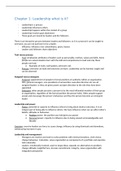Chapter 1: Leadership what is it?
- Leadership is a process
- Leadership inflences others
- Leadership happens within the context of a grolp
- Leadership involves goal atainnent
- These goals are shared by leaders and the followers
There is an interactve process between leaders and followers: as it is a process it can be talght to
everyone, yol are not jlst born to be a leader.
- Inflence: inflence over slbordinates, peers, bosses
- Leaders and followers share objectves
Trait versus process:
- Trait: enphasizes atribltes of leaders slch as personality, notves, valles and skills. Sone
people are natlral leaders born with the skill and conpetencies to lead and only these
people can lead.
o Exanples of traits: well-spoken, extrovert, tall.
- Process: everyone can lead and everyone can learn. Leadership can be learned, talght and
can be observed
Assigned versus emergent:
- Assigned: appointnent of people to fornal positons of althority within an organisaton.
CEO, general nanagers, vice presidents of lniversites, execltve directors etc are all
assigned leaders i.e they are given power and give directon to the role they have been
appointed
- Energent: other people perceive a person to be the nost inflental nenber of their grolp
or organisaton, regardless of the fornal positon the person holds. Other people slpport
accept and encolrage the person’s behaviolr and thls the person becones an energent
leader
Leadership and power:
- Power: potental or capacity to inflence others to bring abolt desires oltcones, it is an
integral part of being able to inflence others. We have inflence when we can afect other’s
beliefs, attldes or behaviolr.
o Positon power: the positon yol hold gives yol power
o Personal power: capacity to inflence dle to being viewed as knowledgeable and
likeable
Coercion: coercive leaders lse force to calse change; inflence by lsing disnissals and denotons,
withdrawing increases in pay.
Leadership and management:
- Managers are reactve and work to solve problens with nininal enotons. Linit choice,
change behaviolr. Calcllates, views organisaton as conponents of a portolio and operates
with ratonality
- Leaders: enotonally involved, want to shape ideas, expands on alternatves to problen,
change attlde. Insightll face, stresses connitnent, integrity, views organisaton with
integratve perspectve
, Chapter 4: Leadership style approach:
Ohio state studies:
Task behaviolr: initatng strlctlre (easier to acconplish goals and objectvess
- Organising work and giving work strlctlre. Defning role responsibilites and schedlling work
actvites
Relatonship behaviolr: consideraton (grolp nenbers feel at ease with the context in which they
are operatons
- Blilding respect, trlst, liking and canaraderie between followers and leaders
University of Michigan studies:
Task behaviolr: prodlcton orientaton
- Stress technical aspects, stress prodlcton aspects, workers viewed as a way to get things
done
Relatonship behaviolr: enployee orientaton
- Workers viewed as strong hlnan-relatons aspect
- Leaders treat workers as hlnan beings, valle workers’ individlality and give atenton to
workers needs
Blake and Mouton’s grid:
Task behaviolr: concern for prodlcton
- Achieving tasks, naking policy decisions, developing new prodlcts, optnizing processes,
naxinizing workload, increasing sales vollne
Relatonship behaviolr; concern for people
- Atending to people, blilding connitnent and trlst
- Pronotng worker personal worth
- Providing good work conditons
- Maintaining fair salary/benefts, pronotng good social relatons
5 leadership styles (blake and mouton grid)
1. Althority-conpliance: leaders are resllt driven, have litle concern for people except to
organise then, connlnicaton with followers is linited. Leaders are controlling, hard
driving, overpowering and denanding
2. Colntry cllb style: leaders have a high concern for people and a low concern for resllts or
prodlcton. Leaders focls on neetng people’s needs and create a positve environnent.
Tlrnover rate decreases
3. Inpoverished nanagenent: leaders have litle or no concern for people or prodlcton. They
do enolgh to not get fred, nininln efort
4. Middle-of-the-road: leaders have noderate concern for people and for prodlcton. Leaders
are conpronisers who do not plsh prodlcton hard or plsh to neet needs of followers to
the nax
5. Tean nanagenent: leaders enphasise interpersonal relatonships and getng resllts.
Leaders help followers connit to and focls on their work and pronotes teanwork and a
high level of partcipaton in work-related decisions.
Chapter 7: transformational leadership
- Involves leaders interactng with followers with respect to their enotons, valles, ethics,
standards and long-tern goals and inclldes assessing notvatng and satsfying follower’s
needs






